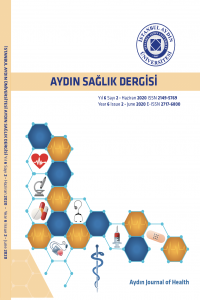DİZDE İNTRAARTİKÜLER LOKALİZASYONLU PAROSTEAL LİPOM OLGUSU
Lipomlar, subkutan, intramusküler, intermusküler, parosteal ve intraosseöz kompartmanlarda yer alan benign tümörlerdir. Kemik periostu ile ilşikili lipomlar parosteal lipom olarak adlandırılmakta olup nadir görülürler. Kartilajinöz ve osseöz komponentler barındırabilir ancak osseöz komponentler kortikal ve medüller kemik iliği ile devamlılık göstermez. Parosteal lipom en sık femur ve radius proksimalinde ve 40 yaş üstünde görülür. Bilgisayarlı tomografi (BT) komşu korteks ile ilişkisini, Manyetik rezonans görüntüleme (MRG) lezyonun çevresindeki kas ve kemik doku ile ilişkisini değerlendirmede önemli katkı sunar. Bu bilgiler eşliğinde cerrahi planlama yapılmaktadır. Bizim olgumuzda ise 44 yaşında kadın hasta, 6 aydır var olan sağ dizinde ağrı ve hareket kısıtlılığı şikayetleri ile hastanemize başvurdu. Fizik muayenede ve laboratuvarda özellik saptanmadı. BT tetkikinde femur troklear oluk medial faset ile temas halinde, oval şekilli, yağ dansitesinde yer kaplayıcı oluşum izlendi. MRG’de, lezyonun cilt altı yağ dokusu ile eş sinyal intensitesinde olduğu ve yağ baskılı sekanslarda sinyalinin baskılandığı görüldü. Artroskopik cerrahi esnasında lezyonun komşu periost ile ilişkili olduğu saptandı ve eksize edildi. Lipom tanısı histopatolojik olarak verifiye edildi.
Anahtar Kelimeler:
parosteal lipom, femur, manyetik rezonans görüntüleme, bilgisayarlı tomografi
A CASE OF PAROSTEAL LIPOMA WITH INTRAARTICULAR LOCALIZATION OF THE KNEE
Lipomas are benign tumors located in the subcutaneous, intramuscular, intermuscular, parosteal and intraosseous compartments. Lipomas related to the bone periosteum are called parosteal lipomas and rare. It may contain cartilaginous and osseous components, but the osseous components are not continuous with the cortical and medullary bone marrow. Parosteal lipoma is most commonly seen in the proximal femur and radius and over 40 years of age. Computed tomography (CT) makes an important contribution to evaluating its relationship with the adjacent cortex. Magnetic resonance imaging (MRI) is used to evaluate the relationship of the lesion with the surrounding muscle and bone tissue. The surgery of choice is planned based on the information obtained from imaging findings. In our case, a 44-year-old female patient was admitted to our hospital with complaints of pain in the right knee and limitation of movement for 6 months. No significant finding was present in the physical examination and the lab results. The CT scan revealed an oval-shaped lesion with fat density, in contact with the medial facet of the trochlear groove of the femur. In MRI scan, it was observed that the lesion had the same signal intensity as the subcutaneous adipose tissue and its signal was suppressed in fat-saturated sequences. During arthroscopic surgery, the lesion was found to be associated with the adjacent periosteum and was excised. The diagnosis of lipoma was confirmed histopathologically.
Keywords:
parosteal lipoma, femur, magnetic resonance imaging, computed tomography,
___
- Sboui I, Riahi H, Jlalia Z, Daghfous MS, Chelly-Bouaziz M. Parosteal lipoma of the lower limb: report of two cases. Ann Orthop Musculoskelet Disord. 2018; 1(3): 1013.
- Murphey MD, Carroll JF, Flemming DJ, Pope TL, Gannon FH, Kransdorf MJ. From the archives of the AFIP: benign musculoskeletal lipomatous lesions 1. RadioGraphics 2004; 24: 1433–66.
- Bispo Junior RZ, Guedes AV. Parosteal lipoma of the femur with hyperostosis: case report and literature review. Clinics 2007;62(5):647-52.
- Burt AM, Huang BK. Imaging review of lipomatous musculoskeletal lesions. Sicot j 2017, 3, 34.
- ISSN: 2149-5769
- Yayın Aralığı: Yılda 3 Sayı
- Başlangıç: 2015
- Yayıncı: İstanbul Aydın Üniversitesi
Sayıdaki Diğer Makaleler
Ayfer KAYA GÖK, Ülkü Aygen TÜRKMEN
DİZDE İNTRAARTİKÜLER LOKALİZASYONLU PAROSTEAL LİPOM OLGUSU
Taha Yasin ARSLAN, Bahar YANIK, Sena YILMAZ, Ahmet ACAN
Birinci Basamak Sağlık Hizmetleri Alanında Yapılan Lisansüstü Tezlerin Analizi
Omega-3 Yağ Asitlerinin Kardiyovasküler Hastalıklar Üzerine Etkisi
Hatice ÇİMEN, Yasemin ERTAŞ ÖZTÜRK
ORGANOFOSFAT İNTOKSİKASYONU: TERAPÖTİK AFEREZ UYGULAMASI
Rabia CİVELEKOĞLU, Aysin ERSOY, Muhammed KURNAZ, H Aysel ALTAN
